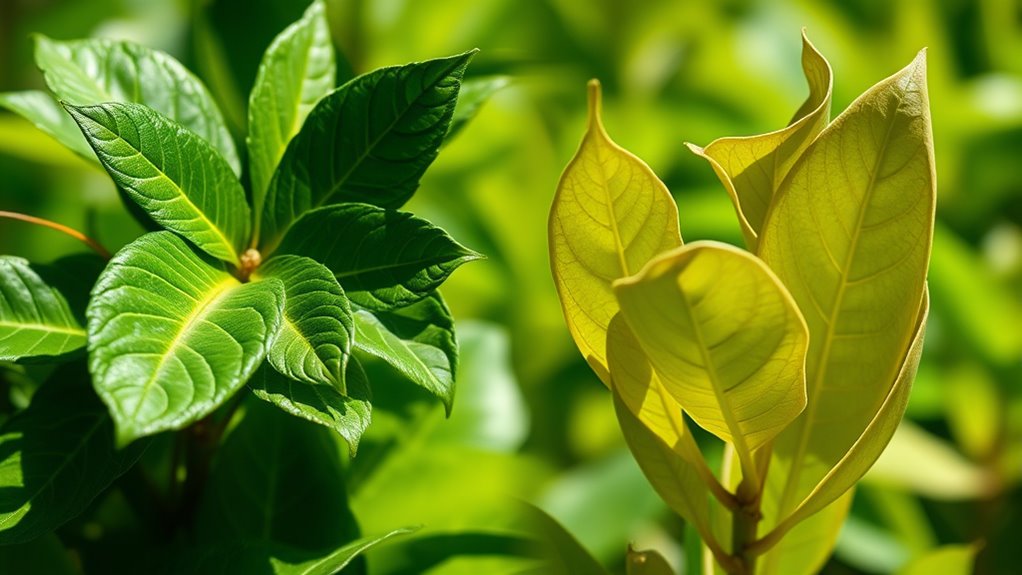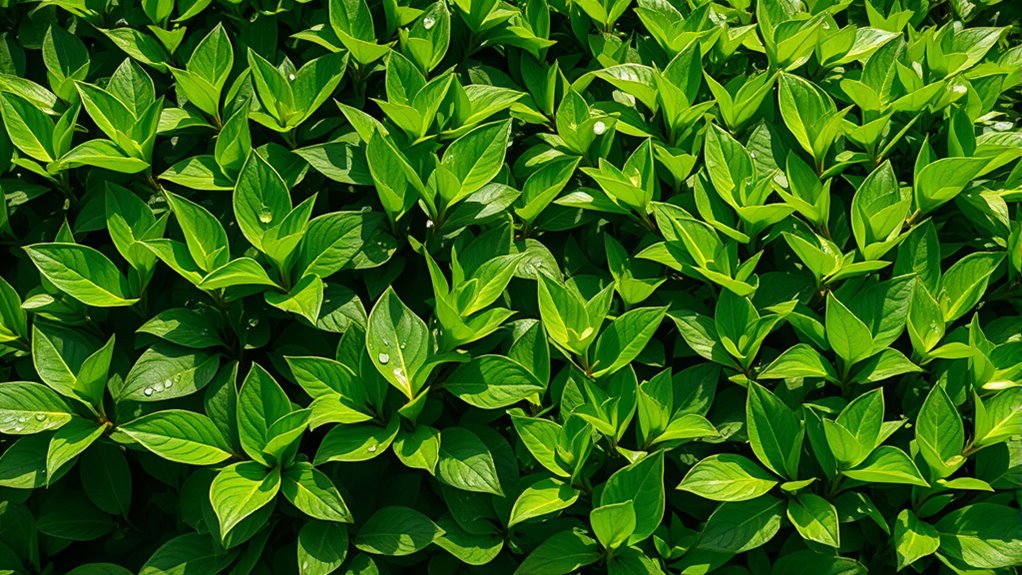Sun-grown teas typically have higher catechin levels because exposure to sunlight triggers the plant to produce more of these antioxidants as a defense. Shade-grown teas usually have lower catechin content, but they tend to have increased theanine and milder flavors. The difference in catechin amounts impacts both flavor and health benefits. Want to find out exactly how these cultivation methods influence other key compounds? Keep exploring to uncover more details.
Key Takeaways
- Sun-grown teas generally contain higher catechin levels due to UV exposure stimulating catechin synthesis.
- Shade-grown teas typically have lower overall catechin content but higher theanine and caffeine levels.
- UV radiation in sun-grown cultivation triggers plants to produce more catechins as a defense mechanism.
- Shade-grown teas tend to have milder flavor profiles with reduced catechins compared to sun-grown varieties.
- Both cultivation methods offer distinct antioxidant profiles, influencing tea’s health benefits and sensory qualities.

Have you ever wondered how the growing environment affects the health benefits of your tea? It turns out that the way tea plants are cultivated markedly influences their chemical composition, especially their catechin levels. Tea cultivation practices, such as shade-growing versus sun-grown methods, play a vital role in determining the antioxidant properties of the final product. When you pick shade-grown tea, you’re choosing leaves that have developed under a canopy of shade, which alters the plant’s stress response and metabolic processes. This environment encourages the plant to produce more chlorophyll and amino acids, but it can also impact catechin synthesis. Conversely, sun-grown teas receive direct sunlight, exposing the plants to higher levels of UV radiation, which often leads to increased production of catechins as a natural defense mechanism.
In shade-grown teas, the reduced exposure to sunlight tends to lower the overall catechin content, especially epigallocatechin gallate (EGCG), which is renowned for its potent antioxidant properties. As a result, shade-grown teas often have a milder flavor profile and slightly fewer catechins compared to their sun-grown counterparts. However, this doesn’t mean they lack health benefits. The shade-growing process boosts the levels of theanine and caffeine, which can complement the antioxidant effects of catechins and contribute to a more balanced, calming experience when you enjoy your tea. The difference in cultivar and specific cultivation practices also influences catechin levels, but generally, shade-grown teas might offer a different antioxidant profile than sun-grown varieties.
On the other hand, sun-grown teas typically contain higher catechin concentrations because the plant responds to intense sunlight by ramping up catechin production as a protective measure. These teas tend to have a more robust flavor and a higher concentration of antioxidant compounds, which can enhance their health-promoting effects. When you choose sun-grown tea, you’re often getting a beverage with a potentially greater capacity to neutralize free radicals, thanks to the elevated catechin levels. Yet, both cultivation methods produce teas with notable health benefits, and your choice can depend on your taste preferences and desired effects.
Frequently Asked Questions
How Does Harvesting Time Affect Catechin Content?
You should consider that harvesting time impacts catechin content considerably. During the harvesting season, leaves are at different stages of maturity, which influences their catechin levels. Younger leaves harvested early in the season typically have higher catechin concentrations, while more mature leaves later in the season may contain less. Timing your harvest carefully ensures you maximize catechin levels, enhancing the tea’s quality and health benefits.
Are Organic Teas Higher in Catechins Than Conventional Ones?
You might wonder if organic teas have higher catechin levels than conventional ones. While organic certification means the tea is grown without synthetic pesticides and has lower pesticide residues, it doesn’t guarantee higher catechin content. Factors like growing conditions, harvest time, and processing influence catechins more. So, choose organic if you want fewer pesticide residues, but don’t assume it automatically has more catechins.
Do Different Tea Plant Varieties Influence Catechin Levels?
Imagine revealing nature’s secret code—your tea’s flavor and catechin levels are heavily influenced by tea plant genetics and varietal cultivation techniques. Different tea plant varieties can dramatically alter catechin content, much like how different musical instruments produce unique sounds. By choosing specific varieties and cultivation methods, you can boost catechin levels, ensuring your tea is both flavorful and packed with health benefits. Varietal cultivation truly shapes your tea’s antioxidant power.
How Does Storage Affect Catechin Stability Over Time?
Storage affects catechin stability considerably over time. If you store tea leaves improperly, tea leaf oxidation accelerates, reducing catechin content. Keep storage temperature cool and consistent to slow down oxidation and preserve catechins longer. Avoid exposure to light and air, as these can also degrade catechins. Proper storage helps maintain tea’s health benefits and flavor, ensuring you get the most out of your tea over time.
Can Brewing Methods Alter Catechin Concentration in Tea?
Imagine brewing tea as painting a vibrant picture. The colors you choose—brewing temperature and steeping duration—can change the scene. Higher temperatures and longer steeping liberate more catechins, like brightening the colors, but risk bitterness. Shorter times and cooler temps preserve delicate notes. So, your brewing method actively influences catechin concentration, shaping the flavor and health benefits just like an artist’s brush strokes craft a masterpiece.
Conclusion
So, next time you choose between shade-grown and sun-grown tea, consider how the growing method influences catechin levels. Shade-grown teas tend to have higher catechin content, offering more antioxidants and potential health benefits. Do you want to enjoy a richer source of these powerful compounds? Ultimately, your choice can impact not just flavor but also your wellness. Why not savor a brew that aligns with your health goals and taste preferences?










